Troctomorpha
Parasitic lice and book lice
Emilie Bess, Vince Smith, and Kevin P. Johnson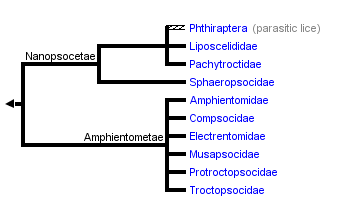


This tree diagram shows the relationships between several groups of organisms.
The root of the current tree connects the organisms featured in this tree to their containing group and the rest of the Tree of Life. The basal branching point in the tree represents the ancestor of the other groups in the tree. This ancestor diversified over time into several descendent subgroups, which are represented as internal nodes and terminal taxa to the right.

You can click on the root to travel down the Tree of Life all the way to the root of all Life, and you can click on the names of descendent subgroups to travel up the Tree of Life all the way to individual species.
For more information on ToL tree formatting, please see Interpreting the Tree or Classification. To learn more about phylogenetic trees, please visit our Phylogenetic Biology pages.
close boxIntroduction
Suborder Troctomorpha comprises 49 families of bark lice, book lice, and parasitic lice in the infraorders Amphientometae and Nanopsocetae.
Discussion of Phylogenetic Relationships
Molecular analysis supports to the placement of the parasitic lice (Phthiraptera) in suborder Troctomorpha, along with the bark lice and book lice families traditionally included in Troctomorpha. Phthiraptera is placed in infraorder Nanopsocetae (18S nDNA, Johnson et al. 2004). Molecular studies of bark lice (excluding Phthiraptera) support the monophyly of Troctomorpha and the infraorders Nanopsocetae and Amphientometae (18S rDNA, and 12S, 16S, COI rDNA, Johnson and Mockford 2003; 18S rDNA, histone3 nDNA, and 16S mtDNA Yoshizawa et al. 2006).
References
Johnson, K. P. & E. L. Mockford. 2003. Molecular Systematics of Psocomorpha (Psocoptera). Systematic Entomology 28: 409-40.
Johnson, K. P., K. Yoshizawa, and V. S. Smith. 2004. Multiple origins of parasitism in lice. Proceedings of the Royal Society of London B 271:1771-1776.
Lienhard, C. and C.N. Smithers. 2002. Psocoptera (Insecta) World Catalogue and Bibliography. Muséum d'Histoire Naturelle, Geneva, Switzerland.
Mockford, E. L. 1993. North American Psocoptera (Insecta). Gainesville, Florida: Sandhill Crane Press.
Smithers, C.N. 1972. The classification and phylogeny of the Psocoptera. Memoirs of the Australian Museum 14: 1–349.
Yoshizawa, K. and K.P. Johnson. 2006. Morphology of male genitalia in lice and their relatives and phylogentic implications. Systematic Entomology 31: 350-361.
Title Illustrations

| Scientific Name | Liposcelis bostrychophila |
|---|---|
| Location | Urbana, Illinois |
| Specimen Condition | Dead Specimen |
| Identified By | E. Mockford |
| Sex | Female |
| Life Cycle Stage | adult |
| Body Part | head |
| View | anterior/lateral |
| Size | 2mm body length |
| Copyright |
© 2006 Emilie Bess

|
| Scientific Name | Echinophthirius horridus |
|---|---|
| Specimen Condition | Dead Specimen |
| Identified By | V. S. Smith |
| Life Cycle Stage | nymph, 2nd stage |
| Copyright | © British Museum of Natural History, London |
| Scientific Name | Damalinia crenelata |
|---|---|
| Comments | Parasite of Damaliscus dorcus |
| Specimen Condition | Dead Specimen |
| Life Cycle Stage | adult |
| Copyright | © British Museum of Natural History, London |
| Scientific Name | Stimulopalpus japonicus |
|---|---|
| Location | Harvard, Ma. |
| Comments | 10/4/2008 |
| Specimen Condition | Live Specimen |
| Life Cycle Stage | adult |
| View | dorsal |
| Copyright | © Tom Murray |
About This Page
Emilie Bess

Illinois Natural History Survey, Champaign, Illinois, USA
Vince Smith

The Natural History Museum
Kevin P. Johnson

Illinois Natural History Survey, Champaign, Illinois, USA
Correspondence regarding this page should be directed to Emilie Bess at
bess@inhs.uiuc.edu
, Vince Smith at
v.smith@nhm.ac.uk
, and Kevin P. Johnson at
kjohnson@inhs.uiuc.edu
Page copyright © 2009 Emilie Bess, Vince Smith , and Kevin P. Johnson
All Rights Reserved.
- First online 09 October 2006
- Content changed 25 March 2009
Citing this page:
Bess, Emilie, Vince Smith, and Kevin P. Johnson. 2009. Troctomorpha. Parasitic lice and book lice. Version 25 March 2009 (under construction). http://tolweb.org/Troctomorpha/30257/2009.03.25 in The Tree of Life Web Project, http://tolweb.org/




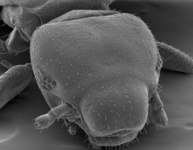
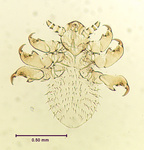

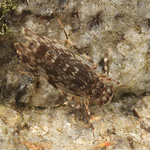
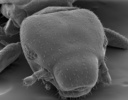


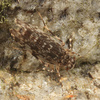

 Go to quick links
Go to quick search
Go to navigation for this section of the ToL site
Go to detailed links for the ToL site
Go to quick links
Go to quick search
Go to navigation for this section of the ToL site
Go to detailed links for the ToL site